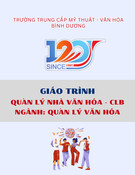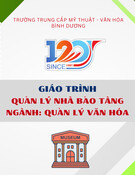
45
HNUE JOURNAL OF SCIENCE
Social Sciences 2024, Volume 69, Issue 4, pp. 45-53
This paper is available online at http://hnuejs.edu.vn
DOI: 10.18173/2354-1067.2024-0066
INDIA’S “SOFT POWER” DURING N.MODI’S ADMINISTRATION
(2014 – PRESENT)
Pham Thi Thanh Huyen
Faculty of History, Hanoi National University of Education, Hanoi city, Vietnam
Corresponding author: Pham Thi Thanh Huyen, e–mail: huyenptt@hnue.edu.vn
Received November 4, 2024. Revised November 26, 2024. Accepted November 28, 2024.
Abstracts. “Soft power” is now genuinely turning into a vital instrument for improving
nations' standing and clout. In that regard, India is likewise increasing its involvement in
global affairs in an effort to increase its influence. India frequently opts for peaceful cultural
dissemination because of its distinctive historical features. This strategy is essential for India
to successfully market its cultural traits. This quality is seen as a potent weapon for India in
expanding its “soft power” around the globe today. Prime Minister Narendra Modi makes
full use of India's unique cultural advantages. Until date, the N. Modi government's
development and use of “soft power” has been a considerable success, drawing the attention
of international leaders. It is clear that the Modi government has opened up the dialogue
between India's “soft power” potential and its foreign policy. For the first time, the Indian
government is beginning to methodically use rich human and cultural resources that have
hitherto evolved independently of official policy. With an interdisciplinary approach, the
article below discusses India's “soft power” building policies during Prime Minister Narendra
Modi's tenure (from 2014 to present), viewing them as one of the secrets to India's remarkable
transformation, assisting the country in establishing its position in the new global order.
Keywords: Great transition, “soft power”, India, Narenda Modi.
1. Introduction
“Soft power” is a scientific concept proposed by Professor Joseph Samuel Nye, Harvard
University, USA, since the 1990s. In the most general sense, national power includes “hard
power” and “soft power”. “Hard power” includes the material parts of the country, which can be
recognized relatively clearly through specific numbers on military potential (quantity and quality
of the army; military equipment, especially nuclear weapons); economic strength (economic
scale, GDP, and economic structure)... In contrast, “soft power” pertains to the intangible
elements of a nation and its influence in international relations. As defined by Professor Joseph
S. Nye, “soft power” is “the ability to get what you want through attraction rather than coercion
or payment; it arises from the appeal of culture, political ideals, and policies of a country.”
(Joseph, N., 2004: 12). As a result, a country is deemed effective in developing soft power when
it affects and obtains support from other countries based on the attractiveness of its culture,
political ideas, and foreign policy (Joseph, N., 2004: 153–171). Christopher A. Ford elaborated:
“Soft power is often used to refer to the collective influence of a country's weight in the economic,
cultural, and political fields, which is essentially all aspects of national power except hard power
coupled with military coercion.” (Christopher, A. F., 2012: 89 – 111).

Pham TTH
46
Some argue that “soft power” is the kind of power that “can easily influence the behavior of
other countries without having to use measurable types of power.” (Goldstein, 2003: 16–17).
Thus, “soft power” is viewed as the invisible force that regulates international interactions. The
notion of “soft power” is sometimes ambiguous and not as easily recognized as “hard power”.
There are several definitions of “soft power” in general. However, the primary issue for
countries to address now is increasing “soft power,” which is the most significant weapon for
fostering economic and diplomatic progress. This is a step toward strengthening the nation's position
in the increasingly competitive and complicated fight for influence in international affairs.
How much “attractive power” does India have? India's soft power has its own civilizational
component: With more than 5,000 years of history, Indian civilization is one of the world's great
cultural forms, influencing religion, philosophy, art, language, literature, trade, and tourism. It is
the birthplace of four of the world's religions: Hinduism, Buddhism, Jainism, and Sikhism.
Having coexisted for millennia, India provides a distinct and syncretic religious discourse. Over
thousands of years of growth, Indian culture has solidified into “Indian identity” and “Indian
spirit”. Like many other great civilizations throughout the world, Indian culture has historically
absorbed numerous foreign cultural components while also leaving a significant mark in various
parts of the world. Traces of Hindu and Buddhist civilizations may still be seen in the cultures of
South and Southeast Asian nations. The difference is that, unlike Chinese culture, the expansion
of Indian cultural values has a calm tone, readily merging and penetrating into the flow of
indigenous traditional culture in other nations with which it comes into contact. As a result of this
merger, the people's and countries' distinct cultures emerge. Thus, it is clear that, from a very
young age, via the transmission of cultural values, India has built a benign image in the minds of
people in various nations and areas throughout the globe. As we enter the twenty-first century,
the world is watching India's astonishing economic rise, which is gradually transforming the
country into a global force. In that environment, India places a high value on developing soft
power resources, which it regards as a critical foundation for connecting with the rest of the world.
Historical, cultural, and political relations have been heavily stressed in India's foreign affairs
efforts since Prime Minister J. Nehru's tenure (1947). The Indian government has long relied on
traditional cultural “characteristics” like Bollywood, yoga, and food as “soft power” tools for
foreign policy formulation and implementation. But, most obviously, in the first decade of the
twenty-first century, with its strong economic development, India concentrated on further
expanding soft power resources in boosting ties with neighboring nations and, more widely, with
Asian countries. India has concentrated on enacting policies to establish and strengthen “soft
power” by supporting long-term internal values such as tradition, culture, history, and many other
elements. Many systematic programs to enhance the importance of “soft power” in the process of
creating and growing the country have been observed, developed, adopted, and carried out,
particularly from 2014 to the present, under President Narendra Modi's tenure. That is regarded
as one of the secrets of India's amazing change, which has helped the nation establish its position
in the new world order.
2. Content
2.1. Policies to build “soft power” during Prime Minister N. Modi period
Recognizing the primary purpose of boosting “soft power” for national development, India
under Prime Minister Narendra Modi established several strategies and action plans to convert
the country's existing resources into “soft power”. Practical experiences show that efforts to
establish “soft power” during Prime Minister Narendra Modi's tenure focus largely on enhancing
traditional culture through media, contemporary science, and technology, supporting both people-
to-people and state diplomacy to boost cultural promotion. Based on that foundation, India first

India’s “soft power” during N.Modi’s administration (2014 – present)
47
succeeded in establishing a “national brand,” resulting in prestige, pervasiveness, and the impact
of “soft power” in its ties with regional and global partners.
Prime Minister Narendra Modi's government prioritizes measures that promote traditional
cultural values in a methodical and effective manner. Unlike past governments, the government
of Prime Minister Narendra Modi has prioritized India's traditional cultural traditions via strategic
investment. Prime Minister Narendra Modi recognizes the importance of traditional culture in
strengthening the country's “soft power.” It is a critical and important resource, a driving factor
for long-term growth in the increasingly severe “soft power” rivalry among nations. As a result,
Prime Minister Narendra Modi stated: “In the contemporary period, which may be regarded as an
era of information, our duties and responsibilities have grown. We must emerge as Vishwa gurus,
not only to give fresh direction for the world but also to defend our legacy” (Martin, P., 2015).
The Narendra Modi government's policies prioritize the development and popularization of
culture through food, dance, classical music, yoga, Ayurveda, festivals, and other forms of art and
culture that reflect India's distinct features. Since 2014, Prime Minister Narendra Modi has
consistently enacted a number of measures aimed at building and developing traditional cultural
values based on contemporary principles. Some common schemes are: “The PRASAD scheme
(Pilgrimage Rejuvenation and Spiritual Augmentation Drive)” , “The Kashi Vishwanath
Corridor project” , “Mahakal Lok project in Ujjain, Madhya Pradesh, and the Maa Kamakhya
Corridor in Guwahati, Assam” , “Chardham Mahamarg Vikas Pariyojna project” ,... Prime
Minister Narendra Modi has employed the policies outlined above to foster cultural diplomacy,
which serves as the foundation for promoting and improving the efficacy of India's “soft power”
regionally and worldwide.
The primary purpose of foreign policy under Prime Minister Narendra Modi has been to
improve the country's standing and reputation in the international arena. Aim to transform India
into a “soft power” powerhouse rather than a middle-class country or worldwide observer. The
focus of Narendra Modi's foreign policy has switched from “Panchsheel” to “Panchamrit,” the
fundamental topic that has driven India's cultural diplomacy campaign over the last decade.
Therefore, the aims of “Panchamrit” include:
1. Dignity and honor (Samman);
2. Increased involvement and discourse (Samvad);
3. Sharing prosperity (Samriddhi);
4. Regional and global security (Suraksha);
5. Linking culture and civilization (Sanskritievam Sabhyata). (Ganguly A., 2015)
To carry out the aforesaid strategy, Prime Minister Narendra Modi's government has
consistently pushed cultural promotion initiatives through state and people-to-people diplomacy.
These policies are applied in a methodical manner and have had a significant positive influence
on India. Prime Minister Narendra Modi pursues diplomatic policies with both regional and
international partners. With a long history of peace and neutrality, India has used its traditional
and historical assets to create contacts with nations all over the world, generating possibilities to
strengthen its place in the global community.
The term “self-reliant India” (in Hindi: “Atmanirbhar Bharat”) refers to Prime Minister
Narendra Modi's strategy for making India self-reliant. It underlines the idea of a self-sufficient
and resilient India that integrates into the global community. The Government of Narendra Modi's
“self-reliant India” strategy is built on five pillars: 1. Creating a new economy (to the tune of
5,000 billion USD); 2. Developing contemporary infrastructure; 3. Establishing a technology-
based distribution system; 4. Capitalizing on the youthful population; and 5. Effectively
leveraging domestic demand.

Pham TTH
48
The term “self-reliant India” is frequently connected with the economic sector and
considerable local production of products and services in response to the worldwide “supply
shock” triggered by the COVID-19 epidemic. However, “self-reliant India” has foreign policy
ramifications. If the domestic policy aim is to minimize reliance on imports of critical products,
the foreign policy goal is strategic autonomy.
“Self-reliant India” is a plan and long-term ambition to transform India into a “self-reliant”
country in economy, politics, and foreign policy. In terms of economics, India must rely on its
own national strength and play a greater role in the global economy. Indian Prime Minister
Narendra Modi affirmed this in his address on the 74th anniversary of India's Independence Day
and the 75th anniversary of the United Nations. (2020) (Hindustan Times: 2020). In international
affairs, India's “self-reliance” strategy is expressed in the flexible use of the idea of “strategic
autonomy” to safeguard its independence, freedom, sovereignty, and territorial integrity. The
“self-reliance” approach in international affairs revolves around diversifying ties. The Indian
government recognizes that, in order to contain China, aligning with a number of strategic allies,
including the United States, is a realistic diplomatic road to moving toward the emerging
multipolar international order that is currently in place. In the midst of rising US-China
competition, India must maintain its independence as a center of power by establishing ties with
neutral states around Asia and the world. For India, a country that cherishes “strategic autonomy,”
the current foreign policy dilemma is no longer a decision between two “giants” or remaining
neutral. It is also an adjustment and adaptation in an age of heavily interconnected networks. To
achieve its core aims, India must convert “strategic autonomy” into a sort of “soft power”. As in
the economic sphere, “self-reliance” in foreign policy does not imply “isolation” or “alliance”
with a superpower but rather collaboration with a number of “like-minded” counterparts. India is
familiar with the term “multi-vector” foreign policy, and it is time to leverage its capabilities.
Clearly, the “self-reliant India” policy represents India's spirit, determination, and strong
drive to attain self-reliance in politics and diplomacy. When India reorganized and opened up in
1991, the notion of “self-reliant India” remained an essential component of India's development
plan into the twenty-first century. As a result, in the complicated regional and international
environment, India's “soft power” is still encouraged and strengthened. Prime Minister Narendra
Modi has adopted a number of programs aimed at growing influence and strengthening ties with
nations and areas throughout the world. Typically, the program upgrades “Look East Policy” to
“Act East Policy” for the Asia-Pacific area and strengthens international ties with Western
nations, particularly significant countries such as the United States, Germany, and France. With
Prime Minister Modi's “neighborhood first” approach in the South Asian area, ties with
neighboring nations such as Bangladesh, Sri Lanka, Nepal, and Bhutan have improved. Along
with that, Prime Minister Narendra Modi underlined the importance of the Indian diaspora abroad
in developing and promoting India's “soft power.” Prime Minister Narendra Modi stated,
“Tomorrow will be India's century, with the country's strength and spirit of reform attracting the
Indian diaspora around the world.” Anirban, G.; Vijay, C.; Uttam, K. S. (2018). While
highlighting the three-dimensional aspects that encourage India's development, Modi adds a
fourth factor, “Diaspora” (Indian Diaspora), which fosters the rise of India's soft power. (Chaulia,
S., 2016).
The focus of India's “soft power” policy under Prime Minister Narendra Modi is on
establishing “yoga diplomacy,” “traditional medicine diplomacy,” “Buddhist diplomacy,” and
film exports (Bollywood).
Yoga is regarded as a traditional cultural value in the heart of Prime Minister Narendra
Modi's campaign to establish “soft power”: “a priceless gift from India to the world.” (Kugiel,
P., 2016). Yoga has a 5,000-year history and is one of India's six most recognized philosophical
traditions. Yoga has great vitality and is growing rapidly because of the mix of spiritual, cultural,

India’s “soft power” during N.Modi’s administration (2014 – present)
49
and health aspects. Although N. Modi's predecessors attempted to expand the impact of yoga over
the world, the results were disappointing owing to the presence of cultural institutions such as the
British Council, Germany's Goethe Institute, and China's network of Confucius Institutes around
the world.
Faced with this circumstance, one of N. Modi's first and most significant responsibilities as
Prime Minister of India was to rally the Indian population throughout the world to fund and
promote Indian culture, particularly yoga. N. Modi is renowned as a leader who effectively
utilizes his talents on social networking sites such as Facebook, YouTube, Tumblr, LinkedIn, and
Pinterest. PM Narendra Modi's personal Facebook page currently has over 50 million followers.
In addition to delivering political ideas, he frequently publishes images, videos, and snippets of
individuals doing yoga, including many Indians. In this approach, he hopes to widely publicize
this amazing health training subject around the world. The Modi government has skillfully
merged “yoga diplomacy” into global affairs. As a result, Narenda Modi stated at a United Nations
General Assembly meeting that yoga is more than just exercise; it is also “a way to change
lifestyle and create consciousness; it can also help us cope with dealing with climate change”
(Asoke, M., 2022). As a result, Modi endorsed the plan, which called for countries to hold
“International Yoga Day”. The United Nations designated June 21st as “International Yoga Day”
in 2015, thanks to initiatives by the Indian government. Thus, “The decision to establish an
international Yoga Day by the United Nations has shown the world's appreciation for India as
well as marked the increase in soft power in this country.” (NDTV, 2015).
Prime Minister Modi's “yoga diplomacy” takes numerous forms, including three key ones:
1: The Indian Prime Minister personally teaches yoga at high-level diplomatic forums, handing
out books and discussing it with leaders such as Australian Prime Minister Malcolm Turnbull, US
President Barack Obama, Russian President Vladimir Putin, and others. 2: organizing yoga
performances during visits and welcoming international heads of state, such as during Prime
Minister Modi's 2015 visit to China, when 400 people performed in front of Prime Minister Modi
and Chinese Prime Minister Li Keqiang; 3: deploying yoga activities globally through the Indian
Embassy abroad on the occasion of “International Yoga Day”. Yoga has become a popular
activity that is rapidly expanding throughout the world, with millions of individuals practicing.
Yoga is becoming more popular not just in India but also in Pakistan, Bangladesh, Sri Lanka,
Thailand, Japan, and Vietnam, as well as in Western nations such as England and France,
America, and Switzerland. Yoga has been done in approximately 200 countries thus far. It might
be argued that yoga has helped to popularize the brand name “India” in nations throughout the
world, therefore laying the groundwork for India's worldwide standing.
Aside from yoga, India is focused on establishing “traditional medicine diplomacy”—
”Ayurveda.”Ayurveda”. Since 2014, the Government of India has aggressively promoted the rich
qualities of traditional medicine and healthcare by strengthening ties with nations in the region
and throughout the globe. Efforts to internationalize traditional medicine are tied to Prime
Minister Narendra Modi's “Healthy India” plan. During the period 2014-2023, the Indian Ministry
of Traditional Medicine, “AYUSH”, consistently contributed favorably to the WHO's
“Traditional Medicine Strategy.” India became a member of the “WHO South-East Regional
Office”. Accordingly, it can be seen: “Traditional medicine is widely popular over the world.
India should lead in this arena, since it not only helps our country make money but also
demonstrates our responsibilities to the globe.” (WHO Regional Office for South–East Asia,
2014).
Spiritual diplomacy is also a priority in India's “soft power” development strategy under
Prime Minister Narendra Modi. The primary focus of spiritual diplomacy is Buddhism: “It is
believed that the twenty-first century will be the century of Asia, and there is no argument about
this... Without Buddha, the century will not be considered Asian.” (Bhavna, V. A., 2015). Based

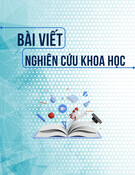

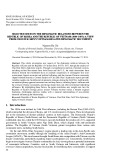
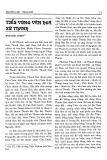
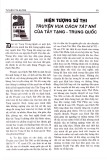
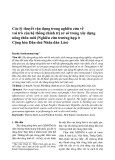

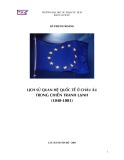
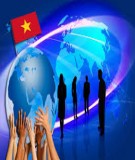

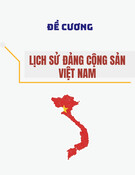
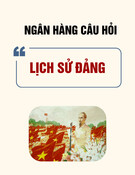

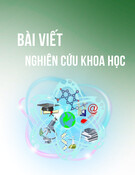
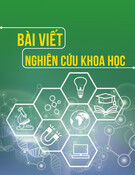
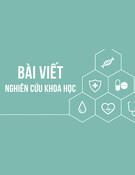

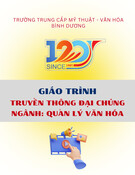

![Giáo trình Tổ chức và Quản lý Hoạt động Văn hóa Thông tin Cơ sở (Ngành Quản lý Văn hóa - Trung cấp) - Trường Trung cấp Mỹ thuật - Văn hóa Bình Dương [Mới nhất]](https://cdn.tailieu.vn/images/document/thumbnail/2025/20251110/kimphuong1001/135x160/17861762748492.jpg)
